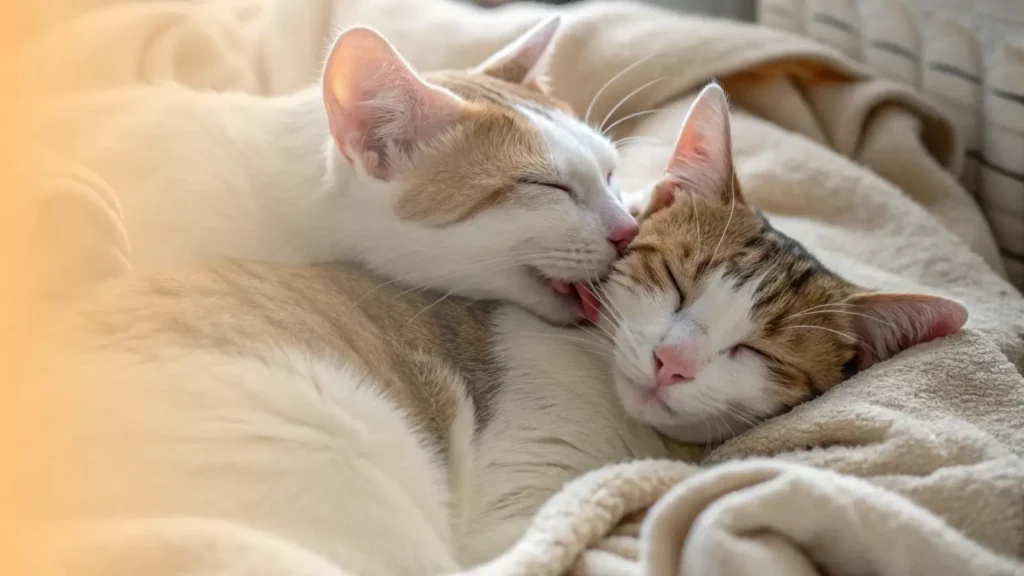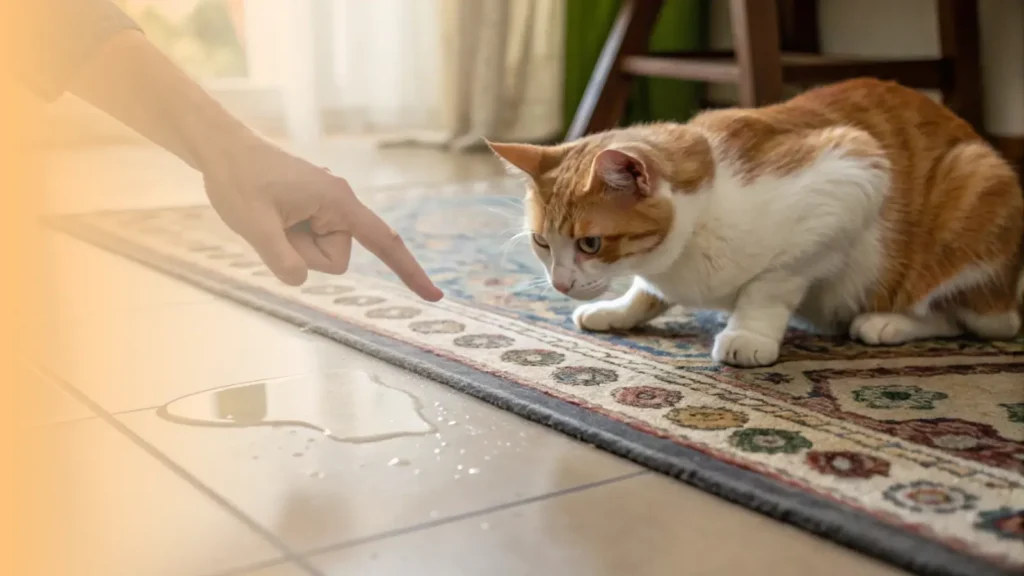It’s one of the sweetest sights a cat owner can see, two of your feline friends curled up together, gently licking and grooming one another.
While it looks like a simple act of keeping clean, this behavior is actually a complex social language cats use to communicate.
The 7 Main Reasons Your Cats Groom Each Other
This fascinating behavior, called allogrooming, is about so much more than hygiene. It is a fundamental part of how cats build their families and live together peacefully. Here are the main reasons your cats spend time grooming their companions.
1. To Build Strong Social Bonds
At its heart, cats grooming each other is a huge sign of trust, friendship, and affection. The feel-good endorphins released during grooming help strengthen this connection.
When one cat licks another, it’s like they are saying, “I trust you, and you are part of my family.” This is one of the clearest ways cats show they have a strong, positive relationship.
Research confirms that cats are much more likely to groom other felines they are familiar with and especially those they are related to, showing just how deep these family ties can run.
2. To Create a Family Scent
A cat’s world revolves around scent, and allogrooming plays a vital role in creating what experts call a “group scent.” Cats have special scent glands on their cheeks, chin, and forehead.
By licking each other in these areas, they mix their individual smells together, creating a unique communal odor for their social group. Think of it as their family’s signature perfume.
This shared scent is incredibly comforting and helps everyone feel safe and secure, instantly letting them know who belongs to their group and who is an outsider.
3. For a Little Stress Relief
The physical act of licking and being licked actually releases endorphins, which are natural feel-good chemicals for cats, just like they are for us. This makes grooming a wonderful stress reliever.
You might notice your cats grooming each other more during times of change, like after a move or during a noisy day.
It is their way of calming each other down and providing mutual comfort when things feel a little uncertain.
4. It Reminds Them of Mom
A cat’s very first experience with grooming comes from its mother. A queen meticulously licks her kittens not just to clean them, but also to provide warmth and even to stimulate them to go to the bathroom.
This constant care creates a powerful, lifelong association between being licked and feeling safe, loved, and cared for. When adult cats groom each other, they are tapping into this deeply ingrained behavior learned in kittenhood.
5. To Help with Hard-to-Reach Spots
While it is mainly a social activity, allogrooming does have a practical side. A cat can’t quite reach the top of its own head or the back of its neck to get them perfectly clean.
Friendly housemates are happy to help, licking these tricky spots to remove any dirt, loose fur, or even fleas. It is a lovely example of cooperative care within their little community.
6. To Show Who Is in Charge
Sometimes, grooming can be a subtle way for cats to navigate their social structure. You might notice that the cat who starts the grooming often sits or stands a little higher, while their partner lies down or crouches.
This isn’t usually an aggressive act but rather a gentle reminder of who holds a higher social position. It is a clever way to keep the peace and maintain group stability without having to resort to a stressful fight.
7. To Keep the Peace
Cats are not big fans of direct conflict, and grooming can be an amazing tool to prevent a squabble. If one cat is feeling a bit tense or agitated, another might approach and offer a few calming licks.
This simple act can diffuse a brewing confrontation and help restore harmony. In a fascinating twist, you might even see the grooming cat give itself a quick wash afterward, which is its own way of shaking off any leftover tension from the situation.
When Good Grooming Goes Wrong
While usually a positive sign, there are times when grooming can signal a problem. Keeping an eye on these interactions helps you know when to step in.
1. You Notice Sore Skin or Bald Patches
If you see thinning fur, red skin, or even scabs on one cat where another has been licking, it is a major red flag. This often means the licking has become obsessive.
The cause is frequently medical, like an underlying itch from allergies or pain that the other cat is trying to “fix.” It is very important to schedule a vet visit to find and treat the root medical cause first.
2. The Grooming Session Ends in a Fight
A healthy grooming session should end with both cats feeling relaxed. If it frequently ends with hissing, swatting, or chasing, something is off.
This often happens because one cat has passed its comfort limit and its subtle cues, like a twitching tail or flattened ears, were ignored. If you see these signs, gently distract the cats with a toy to separate them before a fight can start.
3. One Cat Seems Overly Anxious
Sometimes, a cat will groom another compulsively not because of a problem with the other cat, but because it is feeling stressed itself.
If the over-grooming is paired with other signs of anxiety, like hiding more often or changes in appetite, it is a good idea to look at what might be causing stress in your home.
How to Support Healthy Grooming Habits
You can help ensure grooming remains a positive and peaceful activity in your home with a few simple strategies.
1. Keep Up with Basic Wellness
A healthy cat is less likely to have skin issues that lead to over-grooming. Staying on top of regular flea control and providing a balanced, high-quality diet is a great first step. This reduces itchiness and helps keep their skin and coat in great condition.
2. Provide an Environment of Plenty
Competition over resources is a major source of stress for cats. You can reduce this tension by following the “one plus one” rule.
This means providing one food bowl, water bowl, and litter box for each cat, plus one extra of each.
Spreading these resources out around the home prevents one cat from guarding them and ensures everyone feels secure.
3. Schedule Daily Playtime
Interactive play is a fantastic way for cats to burn off excess energy and stress that might otherwise turn into rough grooming.
Using a wand toy to mimic a hunt for 10 to 15 minutes a day provides great physical and mental exercise.
Finishing a play session with a small treat completes the natural “hunt, catch, kill, eat” sequence and leaves them feeling satisfied and relaxed.
4. Give Your Senior Cat a Helping Hand
As cats get older, stiff joints from arthritis can make it hard for them to groom themselves effectively. You can help by gently brushing your senior cat with a soft brush.
This not only keeps their coat healthy but also means your other cats will have less “work” to do, preventing them from over-grooming their aging friend.
Final Thoughts
The next time you see your cats grooming each other, you’ll know it’s so much more than just bath time. This intricate behavior is a cornerstone of their social lives, helping them build friendships, feel secure, and navigate their relationships. It is a beautiful display of feline connection happening right in your own home.







